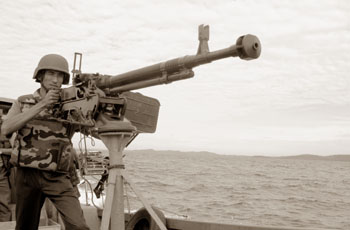|
observer |
|
|
|
|
|
OTHER LINKS |

|

|

|
2006: When talks stalled and troops proceeded
Of course, it was a blood splattered year, compared to the relative calm of the years gone by in the recent past. But, as the year 2006 lapsed, it leaves a positive balance sheet on the battlefront. The Security establishment could retrospect the past year with a position of strength; their strength is their hard earned gain.
A greater part of the credit of this new status quo should go to the forces themselves, who repulsed several decisive Tiger offensives in the country's East and the North. And the political leadership, which didn't succumb to the temptation of politicising the military successes - contrary to the conduct of its predecessors who made not only political, but also financial gain out of war - should deserve a salutation. A virtual war was thrust on the newly elected President Mahinda Rajapaksa within days of his election to the Presidency. A few weeks into his election, the LTTE carried out a string of claymore explosions, killing scores of the security forces personnel and testing the resolve of the new administration. Trademark strategyThe LTTE conduct was part of its trademark strategy to intimidate the government in to submission. However the political leadership exhibited a greater resolve which was absent in its predecessor. A catalyst to the recent military success was the appointment of Lt. General Sarath Fonseka as the Commander of Army. A year since then, the government stands almost about to capture the last bastion of the LTTE in the East, Vakarai. Where the negotiations failed, military has succeeded, at least for the time being. Of course, negotiations remain to be the key to a durable peace. However, history of peace talks world wide is that talks with any potent militant group -including the LTTE itself- have a little chance of success, unless the terror group is challenged through effective military means. Militant groups with a significant military strength have hardly offered to strike a political compromise with the state actors till its military strength is compromised. An example is Kurdish Workers Party (PKK), one of the pioneers in suicide bombing, whose struggle for an independent Kurdish state in the majority Kurd areas in Turkey killed 30,000 people. PKK gave up violence, only when its leader Abdulla Ocalan was arrested. Sri Lanka's JVP would be another example, considering the 1987/89 era. The initial casualty figures during the late November and December of 2005 indicated the troops had been taken by surprise. Most claymore explosions were directed at security forces convoys. Troops apparently lacked any deterrent capacity against such attacks. The LTTE strategy was to hinder the mobility of the security forces and gradually confine them to the barracks. That was a strategy similar to how it gradually took control of Jaffna in the mid eighties. By the time, the LTTE planed to revisit the very strategy in late 2005, it had already set up its support networks and sleepers in the peninsula thanks to the freedom of movement offered under the ceasefire agreement. A civilian militia named Makkal Padei had been trained and were used in covert attacks against the security forces. There was a palestine style intifada in the making in the Jaffna Peninsula, manipulated by the LTTE, which exploited the ceasefire agreement for its advantage. It was not a full blown war, but an insurgency set to disrupt the functioning of the state apparatus - and of course it military apparatus- in the peninsula. That was also the making of the Chandrika Kumaratunga Administration, which failed to sanction counter military measures as LTTE stepped up violence during the latter end of 2005. All what required was the political will to sanction certain counter-terrorist measures, which was done by the Rajapaksa Administration. This turned the tables and within weeks security forces could take control of the volatile situation in the peninsula. Later, several incidents, some were fatal miscalculations of the LTTE on the resolve of the security forces and the Rajapaksa Administration, which were to follow were instrumental in security forces taking the upper hand in the situation. Attack on Army CommanderThe LTTE targeted Army Commander Gen. Fonseka in a suicide bombing inside army headquarters on April 25 as the Norwegians were tenuously campaigning to bring the two parties to the second round of Geneva talks. Gen Fonseka survived, but the blast questioned the LTTE's sincerity for a negotiated settlement and provided the government a seemingly justification to authorise air strikes against the LTTE positions for the first time during the ceasefire. If the failed suicide attempt on the Army Commander shattered the last semblence of already flattering mutual confidence between the two parties, the events to follow justified the government's act tough policy against the LTTE violence. Among them were the Kebithigollewa bombing, LTTE artillery strikes on the Trinco naval base, the killing of Major Gen Parami Kulatunge, Mavil Aru water dispute and subsequent simultaneous attacks on military outposts of Mahindapura, Kattaparichchan, Selvanagar and Mutur Jetty and finally the LTTE's miscalculated offensive on the Muhamalai-Nagar Kovil forward defence lines of the security forces. Air operations in the past year proved to be extremely effective in destroying LTTE's military infrastructure. This resulted in the LTTE to suspend moves to develop an air wing after its airstrip near the Iranamadu lake was bombed by the Air Force. The LTTE is still believed to be in possession of several two-seater micro light aircraft which can be used in a suicide mission against a key military or civilian installation. However, the air strip and its "air wing" were more of a symbolic value to the LTTE, representing another branch of what the Tigers believe of emerging "Eelam state." Though,it looked a simple bravado, given international response to such a move - a dilemma aggravated by geo-political reasons- sanctioning deterrent measures at that point was an illustration of the will of the Rajapaksa Administration to act decisively, perhaps even to test the international opinion. MiscalculationThe LTTE's misfortune in the past year was partly due to its own miscalculation. Two major battles, one in the East and other in the North, had a fatal blow on its military machinery. The simultaneous LTTE attacks on four military camps in Kattaparichchan, Selvanagar, Mahindapura and Mutur on August 1, which saw an exodus of Mutur Muslims to Kantale was a miscalculation of the LTTE of the preparedness of the security forces. Interestingly enough, the attack was carried out in the East, when several hundreds of additional troops had been brought to the East for the Operation Watershed (Mavil aru). This enabled an speedy reinforcement of troops to besieged camps. Added with this, as illustrated in Kattaparichchan, where an young Captain and just 70 odd soldiers fought five hundred LTTE cadres for four days, the LTTE also underestimated the resolve of the security forces to fight the enemy. The same misjudgment was repeated when the LTTE attempted to overrun the security forces forward defence lines in the northern front on August 11. Troops fought for three weeks, repulsing several Tiger attempt to overrun the FDL, killing over 700 LTTE cadres. The battle in Mutur-Kattaparichchan where an estimated 400 LTTE cadres were killed, according to the army and that of Muhamalai-Nagarkovil severely dented the LTTE's man power. Added with those who were seriously injured in the operation- estimated to be 1500, which would keep them away from the battle front for a considerable time, the two battles neutralised 1/3 of the LTTE's fighting cadre estimated to be around 7,000. This is basically the main reason for the fact that the LTTE did not launch any major offensive since the failed August 11 mission. This has however increased the danger of the Tigers opting to suicide commando style operations on key military and economic targets and suicide missions against the VIP targets. several suicide missions had already been staged by the LTTE, latest being the failed attempt at the life of the Defence Secretary Gotabhaya Rajapaksa. The other setback for the LTTE was the gradually tightening noose of the international community which culminated with the ban by the 25 nation European Union. Not only had the ban been devastating on the international fund raising activities of the LTTE, it did also question the legitimacy of the LTTE's claim to be the sole representatives of the Tamils. And the post-9/11 world opinion rejects the LTTE's notion of a "liberal struggle". The LTTE networks in the Western hemisphere, specially in the US and Canada were brought under intense scrutiny and several LTTE agents, who negotiated to buy S 18 anti-aircraft missiles were arrested by the undercover FBI agents. Collapse of SampurIn the East, the LTTE stands to loose its last bastion, Vakarai. The collapse of Sampur negated its ability to disrupt the functioning of the Trinco harbour, the life -line of over 35,000 security forces. The increasing casualties in the fight to hold Vakarai coupled with recent military setbacks of the LTTE could have a devastating effect on the motivation of ordinary LTTE cadres to carry on the fight. The rise of Karuna faction in the East, could deter the rebuilding the LTTE in the East. The security forces in the past few months have reported over 100 LTTE cadres have surrendered in the East. And the numbers who deserted the LTTE without the knowledge of the security forces could be higher. Added with this, the security forces have noticed in the recent months that no single LTTE cadre had opted to swallow the cyanide capsule to avoid the arrest, rather than preferring to give themselves up. However, in the final analysis, the military success alone could not solve the ethnic conflict. A political solution to the grievances of the ethnic minorities remains the main thrust in a durable peace. The government's sincerity to address the aspirations of Tamils and its willingness to walk the extra-mile to seek a solution, remain to be the key to a sustainable political solution. The MoU between the main Opposition UNP and the ruling SLFP has already provided a window of opportunity for a bipartisan approach. That is an opportunity to be grasped. One thing is clear that without a political solution, it may not be easy to sustain the military gains on a long term. |
 At the end of 2005, Prabhakaran launched an undeclared war against
the Government and the newly elected President. A year since then, the
Security forces could look back from a position of strength. But still,
a political solution is the key to peace.
At the end of 2005, Prabhakaran launched an undeclared war against
the Government and the newly elected President. A year since then, the
Security forces could look back from a position of strength. But still,
a political solution is the key to peace. 








